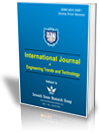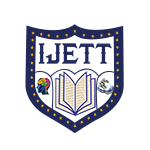Camargo’s Indexive Filtering based Affine Invariant Sliced Regression for Ulcer Prediction Using Wireless Capsule Endoscopy Images
Camargo’s Indexive Filtering based Affine Invariant Sliced Regression for Ulcer Prediction Using Wireless Capsule Endoscopy Images |
||
 |
 |
|
| © 2025 by IJETT Journal | ||
| Volume-73 Issue-3 |
||
| Year of Publication : 2025 | ||
| Author : S. Bhuvaneswari, M. Sulthan Ibrahim |
||
| DOI : 10.14445/22315381/IJETT-V73I3P138 | ||
How to Cite?
S. Bhuvaneswari, M. Sulthan Ibrahim, "Camargo’s Indexive Filtering based Affine Invariant Sliced Regression for Ulcer Prediction Using Wireless Capsule Endoscopy Images," International Journal of Engineering Trends and Technology, vol. 73, no. 3, pp. 540-553, 2025. Crossref, https://doi.org/10.14445/22315381/IJETT-V73I3P138
Abstract
An ulcer is a sore or lesion that forms in the coating of Gastro Intestinal (GI) area. The most common ulcers develop in the small intestine and stomach. In GI, ulcers tract potentially lead to serious conditions like Crohn’s disease and ulcerative colitis. Conventionally, detection of ulcers in the GI tract involves endoscopy techniques, which are uncomfortable for patients, and these methods may not effectively visualise the small intestine area. Therefore, WCE is the essential diagnostic task for examining the GI tract. Conventionally, ulcer detection using machines and DL methods has been developed through early detection and treatment. However, achieving accurate ulcer detection with minimal time complexity is a significant challenge. A novel technique called Camargo’s Indexive Kuwahara Filtering Based Affine Invariant Sliced Regression (CIKF-AISR) is introduced to enhance accuracy and minimise time complexity. The proposed CIKF-AISR technique includes three major processes: image acquisition, preprocessing and feature extraction. First, the numbers of WCE images are collected from the dataset. After the image acquisition, preprocessing is carried out to eradicate noise and protect edges by applying an adaptive Camargo’s indexive Kuwahara filtering technique for image smoothing. This helps to reduce MSE and increase PSNR. The segmentation and feature extraction process is executed to minimise the time complexity of ulcer detection. Von Neumann locality segmentation is employed to segment the image into different regions and extract the ROI with the help of Canberra distance measure between the image pixels. Then, dissimilar features are extracted using the Affine invariant saliency Sliced regression method. After extracting the features, ulcer detection is performed with higher accuracy. Experimental evaluation is carried out on several factors. The analysed results indicate that the CIKF-AISR technique achieved better performance in accuracy, PSNR, and precision and less time compared to conventional methods.
Keywords
Adaptive Camargo’s indexive Kuwahara filtering technique, Affine invariant saliency, Sliced regression method, Ulcer detection, Von Neumann locality segmentation, Wireless capsule endoscopy images.
References
[1] V. Vani, and K.V. Mahendra Prashanth, “Ulcer Detection in Wireless Capsule Endoscopy Images Using Deep CNN,” Journal of King Saud University - Computer and Information Sciences, vol. 34, no. 6, Part B, pp. 3319-3331, 2022.
[CrossRef] [Google Scholar] [Publisher Link]
[2] Deepak Bajhaiya, Sujatha Narayanan Unni, and A.K. Koushik, “Deep Learning-Powered Generation of Artificial Endoscopic Images of GI Tract Ulcers,” iGIE, vol. 2, no. 4, pp. 452-463, 2023.
[CrossRef] [Google Scholar] [Publisher Link]
[3] João Afonso et al., “Development of a Convolutional Neural Network for Detection of Erosions and Ulcers with Distinct Bleeding Potential in Capsule Endoscopy,” Techniques and Innovations in Gastrointestinal Endoscopy, vol. 23, no. 4, pp. 291-296, 2021.
[CrossRef] [Google Scholar] [Publisher Link]
[4] Hsu-Heng Yen et al., “Performance Comparison of the Deep Learning and the Human Endoscopist for Bleeding Peptic Ulcer Disease,” Journal of Medical and Biological Engineering, vol. 41, pp. 504-513, 2021.
[CrossRef] [Google Scholar] [Publisher Link]
[5] Ibrahim Abdulrab Ahmed, Ebrahim Mohammed Senan, and Hamzeh Salameh Ahmad Shatnawi, “Hybrid Models for Endoscopy Image Analysis for Early Detection of Gastrointestinal Diseases Based on Fused Features,” Diagnostics, vol. 13, no. 10, pp. 1-30, 2023.
[CrossRef] [Google Scholar] [Publisher Link]
[6] Mehrdokht Bordbar et al., “Wireless Capsule Endoscopy Multiclass Classification Using Three-Dimensional Deep Convolutional Neural Network Model,” BioMedical Engineering Online, vol. 22, no. 1, pp. 1-23, 2023.
[CrossRef] [Google Scholar] [Publisher Link]
[7] Tom Kratter et al., “Deep Learning Multi-Domain Model Provides Accurate Detection and Grading of Mucosal Ulcers in Different Capsule Endoscopy Types,” Diagnostics, vol. 12, no. 10, pp. 1-11, 2022.
[CrossRef] [Google Scholar] [Publisher Link]
[8] Muhammad Attique Khan et al., “Computer-Aided Gastrointestinal Diseases Analysis from Wireless Capsule Endoscopy: A Framework of Best Features Selection,” IEEE Access, vol. 8, pp. 132850 -132859, 2020.
[CrossRef] [Google Scholar] [Publisher Link]
[9] Suliman Mohamed Fati, Ebrahim Mohammed Senan and Ahmad Taher Azar, “Hybrid and Deep Learning Approach for Early Diagnosis of Lower Gastrointestinal Diseases,” Sensors, vol. 22, no. 11, pp. 1-31, 2022.
[CrossRef] [Google Scholar] [Publisher Link]
[10] Miguel Martins et al., “Deep-Learning and Device-Assisted Enteroscopy: Automatic Panendoscopic Detection of Ulcers and Erosions,” Medicina, vol. 59, no. 1, pp. 1-8, 2023.
[CrossRef] [Google Scholar] [Publisher Link]
[11] J. Yogapriya et al., “Gastrointestinal Tract Disease Classification from Wireless Endoscopy Images Using Pretrained Deep Learning Model,” Computational and Mathematical Methods in Medicine, vol. 2021, pp. 1-12, 2021.
[CrossRef] [Google Scholar] [Publisher Link]
[12] Naoki Higuchi et al., “Automated Evaluation of Colon Capsule Endoscopic Severity of Ulcerative Colitis Using ResNet50,” PLoS One, vol. 17, no. 6, pp. 1-13, 2022.
[CrossRef] [Google Scholar] [Publisher Link]
[13] Paolo Biamonte et al., “New Technologies in Digestive Endoscopy for Ulcerative Colitis Patients,” Biomedicines, vol. 11, no. 8, pp. 1-16, 2023.
[CrossRef] [Google Scholar] [Publisher Link]
[14] Ge Wang et al., “Cb-HRnet: A Class-Balanced High-Resolution Network for the Evaluation of Endoscopic Activity in Patients with Ulcerative Colitis,” Clinical and Transaction Science, vol. 16, no. 8, pp. 1421-1430, 2023.
[CrossRef] [Google Scholar] [Publisher Link]
[15] Reed T. Sutton et al., “Artificial Intelligence Enabled Automated Diagnosis and Grading of Ulcerative Colitis Endoscopy Images,” Scientific Reports, vol. 12, pp. 1-10, 2022.
[CrossRef] [Google Scholar] [Publisher Link]
[16] Benjamin Gutierrez Becker et al., “Training and Deploying a Deep Learning Model for Endoscopic Severity Grading in Ulcerative Colitis Using Multicenter Clinical Trial Data,” Therapeutic Advances in Gastrointestinal Endoscopy, vol. 14, pp. 1-15, 2021.
[CrossRef] [Google Scholar] [Publisher Link]
[17] Heming Yao et al “Fully Automated Endoscopic Disease Activity Assessment in Ulcerative Colitis,” Gastrointestinal Endoscopy, vol. 93, no. 3, pp. 728-736, 2021.
[CrossRef] [Google Scholar] [Publisher Link]
[18] Jing Qi et al., “PHF3 Technique: A Pyramid Hybrid Feature Fusion Framework for Severity Classification of Ulcerative Colitis Using Endoscopic Images,” Bioengineering, vol. 9, no. 11, pp. 1-19, 2022.
[CrossRef] [Google Scholar] [Publisher Link]
[19] Ji Eun Kim et al., “Deep Learning Model for Distinguishing Mayo Endoscopic Subscore 0 and 1 in Patients with Ulcerative Colitis,” Scientific Reports, vol. 13, no. 1, pp. 1-9, 2023.
[CrossRef] [Google Scholar] [Publisher Link]
[20] Jing Qi et al., “Development and Validation of a Deep Learning-Based Approach to Predict the Mayo Endoscopic Score of Ulcerative Colitis,” Therapeutic Advances in Gastroenterology, vol. 16, pp. 1-13, 2023.
[CrossRef] [Google Scholar] [Publisher Link]
[21] Kathiresh Murugesan et al., “Homomorphic Encryption, Privacy-Preserving Feature Extraction, and Decentralised Architecture for Enhancing Privacy in Voice Authentication,” International Journal of Electrical and Computer Engineering, vol. 15, no. 2, pp. 2150-2160, 2025.
[CrossRef] [Google Scholar] [Publisher Link]
[22] Sahira Vilakkumadathil, and Velumani Thiyagarajan, “Exploring Diverse Prediction Models in Intelligent Traffic Control,” Indonesian Journal of Electrical Engineering and Computer Science, vol. 38, no. 1, pp. 393-402, 2025.
[CrossRef] [Publisher Link]
[23] Ramaraj Muniappan et al., “Optimisation Techniques Applied on Image Segmentation Process by Prediction of Data Using Data Mining Techniques,” International Journal of Electrical and Computer Engineering, vol. 15, no. 2, pp. 2161-2171, 2025.
[CrossRef] [Google Scholar] [Publisher Link]
[24] Velumani Thiyagarajan et al., “Adaptive Feature Learning for Robust Pathogen Detection in Plants,” 2024 4th International Conference on Sustainable Expert Systems, Kaski, Nepal, pp. 1347-1353, 2024.
[CrossRef] [Google Scholar] [Publisher Link]

